You know how talent often runs in families? This month's artist feature, with painter Lawrence Dyer, is part of that tradition. I first met his daughter, Madeline Dyer, when I discovered her beautiful and powerfully written first book, Untamed (read our author interview here). Imagine my NOT surprise when I saw her father's artwork in one of her facebook posts. The same extraordinary talent, in a different form - THIS is the Dyer legacy, I think - to impact the world in their own way, with words and images, and art from the heart.
Lawrence Dyer is a professional artist based in the UK. He mainly paints seascapes and landscapes but also portraits. He is often to be found on the wild beaches of southwest England, painting outside.
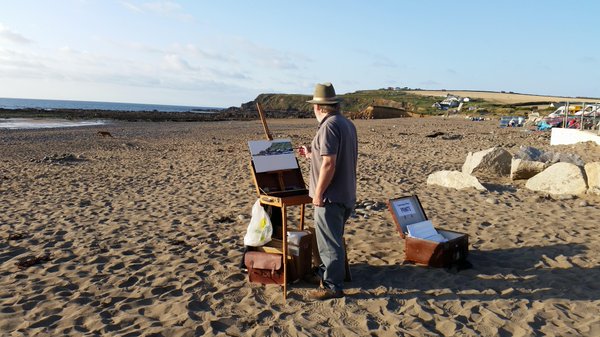
Painting at Widemout Bay, Cornwall
When I first saw Lawrence's paintings, I was transported - right to those wild beaches of southwest England, hearing the crashing waves, feeling the frisky breeze, reveling in being there. Take a look - and come along on a journey with Lawrence Dyer, our artist of the month.

Sea Pounded Stones

Millook Haven
How long have you been an artist?
I’ve been an artist since I was a very small child. By this, I mean drawing and painting, but also the way I looked at things and wanted to capture their unique qualities. By the time I was eight, I had a reputation in my class at school as being good at art, and it carried on from there. When I reached adulthood, I intended to make art my profession but due to family circumstances I went down the road of studying and teaching English literature. This meant I did not start to earn my living from art until later in life.

River Taw Sticklepath

River Dart, Dartmoor
Is your art your full-time career?
Yes.
Where do you work? How long have you been there?
I work from my studio at home in North Devon, United Kingdom, and I also paint outside on local beaches. The latter is very much seasonal, particularly as the climate of North Devon and nearby North Cornwall, where I usually paint, is a very wet one. So, for painting outside I’m limited to about six months of the year. During the winter months, I work from photographs and from memory in the studio, and also in the shared studio of a group of artists I meet up with once a week.

Wave Plumes
Do you have favorite places you like to create?
Yes, I tend to return to the same places on a regular basis, particularly on the North Cornwall coast, around Bude, but also in South Devon around Sidmouth. (The South West of England, being a peninsula, has a North and a South coast, both of which are fairly accessible to me.) Working in the same places gives me the advantage that local people as well as vacationers get to know my work and become customers.

Lawrence Dyer painting at Sidmouth, Devon
What does a typical day look like? Is there a typical day?
This would depend on whether I’m painting outside or in the studio. A typical day when I paint outside would consist of checking and getting ready my equipment—paint, solvent, painting medium, palette, brushes, pochade box, painting boards, and so on. Then taking the short drive to the coast, and setting up on the beach for the rest of the day.
A day spent working at home would usually consist of admin, answering messages, and doing marketing stuff in the morning, followed by painting in the studio in the afternoon and often in the evening too. Sometimes, I go on until midnight or beyond with the help of artificial daylight lamps.

Warren Point
What medium do you paint in?
I’m an oil painter primarily. This applies when I am painting seascapes and landscapes, as well as portraits. I also use charcoal and pastels for some portraits and life drawings. When using oil paint, I mainly paint on high quality archival panels these days, as I like the fact that they have a smoother surface than canvas and they are more durable than canvas over time.
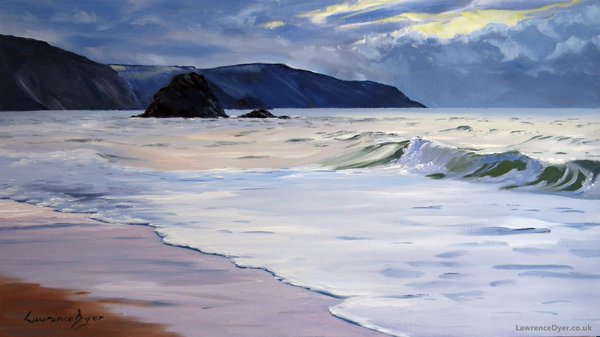
The Black Rock
What colors do you use in your palette?
Depending on the subject matter of the painting, I try to keep my palette restricted to as few colors as possible. For seascapes, I generally use two blues—French Ultra Marine and Pthalo Blue; two yellows—Cadmium Yellow and Lemon Yellow; Burnt Sienna, Cadmium Red, Quinacridone Magenta, and Titanium White. This will vary depending on the painting, but not much. Having tried various brands in the past, I favor Winsor and Newton professional oil paints. I don’t use Luiquine or Alkyd paints as apart from the smell, I think traditional paints work better.
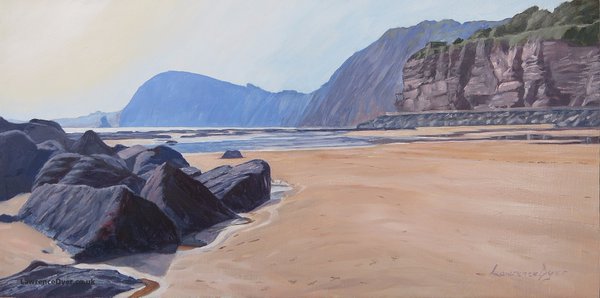
High Peak Sidmouth
Where/How are you inspired?
I’m inspired by light and the beauty it creates. This translates in practice into the wonderful light of the beautiful coastlines of this area, and also the often-dramatic lighting of Dartmoor, (which is a mountainous national park in the South West of England). The coastlines of North Cornwall which I paint are characterized by near vertical rocky cliffs, constantly battered by large Atlantic breakers. Cornwall is well-known for that kind of scenery, of course.

Warren Point Sunset
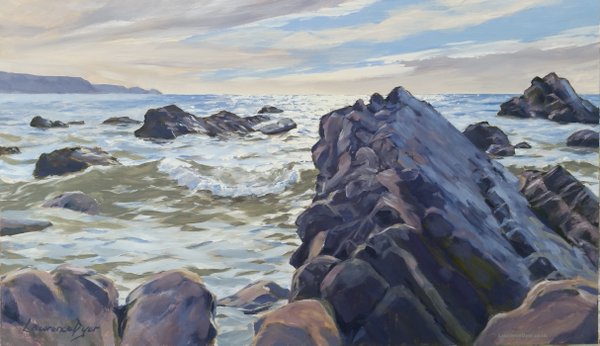
Rocks At Widemouth Bay, Cornwall
How do you know when your piece is done?
This is a good question, because all too often artists continue to add to a work long after they should have stopped. The secret, if there is one, is to do enough to convey your intentions and then stop before you mess it up. I read somewhere that every artist should be accompanied by someone with a hammer who is there to hit him or her on the head the moment they reach the point where a painting is finished.
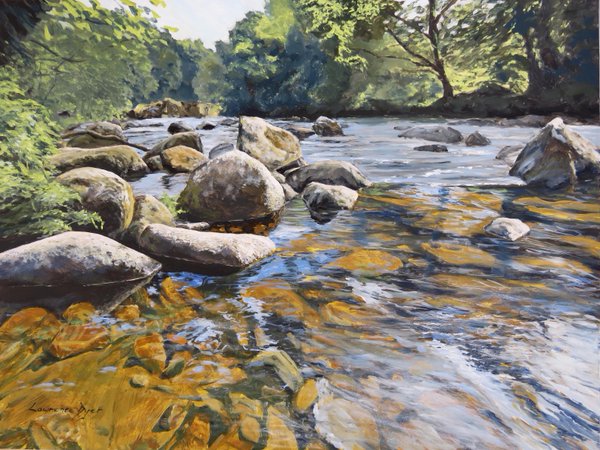
River Dart, Devon

March Morning, Crackington Haven
Do you work on one or more pieces at a time?
Usually, I only work on one piece at once, unless it is a commission, in which case it may be spread out over a bit more time. All of this means that I generally paint wet-in-wet, which means putting new paint onto wet paint that is already on the canvas (or panel). Painting wet-in-wet has advantages and disadvantages. You are often able to obtain a life and immediacy -- a freshness -- which is harder to achieve in a painting painted over a longer period. The disadvantage is that by restricting yourself in time (to an afternoon at the beach, for example) it’s harder to get everything right in one go, but it does come with practice.
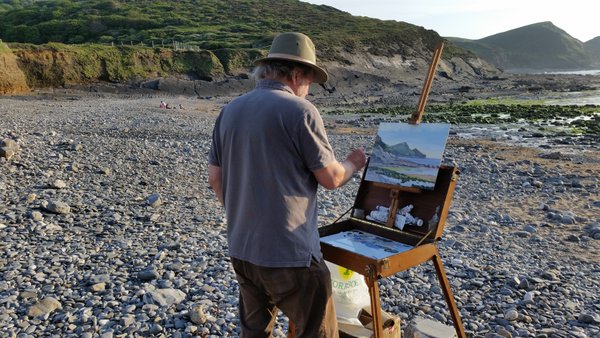
Painting at Crackington Haven, Cornwall
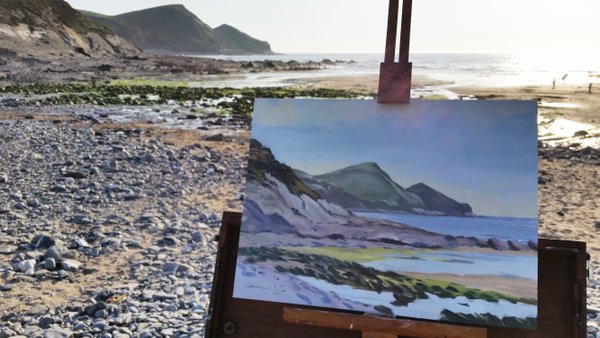
Plein Air Painting at Crackington Haven, Cornwall
What style do you paint in?
Realism. This ranges from a somewhat more detailed kind of realism through to a more impressionist approach. By ‘impressionist’ here, I don’t mean the vague use of the term as it is often used online, but the specific kind of impressionism typical of plein air painters of the early twentieth century. This is where painters put capturing light and general form above slavish detail. Unfortunately, nowadays the term ‘impressionism’ tends to get used for any old vagueness, and has lost its original meaning in some quarters.

Fat Wave
Who has influenced you?
I’ve been influenced by realist/impressionist painters such as John Singer Sargent and Joaquin De Sorolla. In terms of seascapes, Frederick Judd Waugh has been a big influence for his understanding of the sea, though not so much his style. I also like some of the work of David Curtis,the Scottish seascape painter. I also like the railway posters of Normal Wilkinson. Of contemporary painters working now, I like the work of Michael B. Karas, Jeremy Lipking, and some of Andrew Tischler’s paintings are very good, too. Also, Alexei Adamov, amongst others.

Glowing Skies, Pencannow
If you were not a painter, what would you do?
I’m also a writer, having a number of published speculative fiction short stories in British magazines, as well as a published autobiographical book called ‘A Cottage on the Moss’, about living in a remote stone cottage in the Peak District National Park. So, if I was not an artist, I would concentrate solely on my writing.

Okement River
How can our readers find and purchase your art?
First of all, my original artworks are for sale, and can be viewed on my website, LawrenceDyer.co.uk and at LawrenceDyerFineArt.com, as well as my facebook page: https://www.facebook.com/LawrenceDyerArtist. Those interested are invited to email me for more details at Lawrence [at] LawrenceDyer [dot] com.
Secondly, almost all of my paintings are available more cheaply in the form of prints. These can be purchased worldwide directly through the website at FineArtAmerica.com/profiles/lawrencedyer/shop or again by contacting me if a hand-signed and numbered limited edition is preferred.

All photos courtesy and copyright Lawrence Dyer
